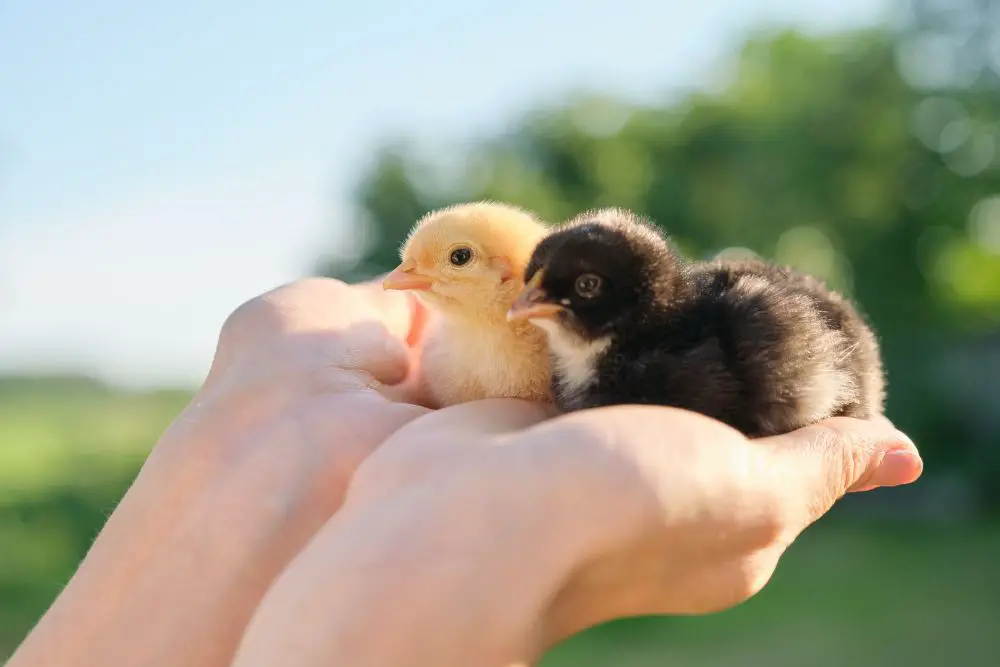The most effective way to tell if your baby chick is a rooster is through vent sexing via simply looking inside a baby chick's vent. You can also look at their comb, wings, legs, or using the hackle and saddle method.
Keen to know whether your baby chicks will be roosters or hens? Although it is easy to differentiate between mature hens and mature roosters, it is difficult to identify the sex of newly-hatched chicks.
You might not be able to accurately tell if a chick is a cockerel or pullet until it reaches at least 16 weeks of age. In this guide, you’ll discover 6 ways of how to tell if your young chicks are roosters or hens.
Table of Contents
Vent Sexing Chicks
Vent sexing chicks is an old practice that hatcheries and breeders employ to differentiate between young hens and young roosters.
The practice involves checking the baby chick’s vent or cloaca, located beneath the tail, searching for a sex organ. If a genital organ is visible in the chick’s vent, the chick will become a young rooster.
This practice should be left to the experts who have undergone thorough training to safely and accurately employ this method.
If done properly, vent sexing is an accurate way of telling the sex of young chicks. However, we don’t recommend doing this yourself because you could end up harming the chick.
The process entails squeezing the poop from the baby chicken’s vent, and allows the vent sexer to determine whether the chick has a genital organ (typically a small pimple inside). Roosters have a small bump or pimp inside, while hens don’t.
Using Comb Size and Color
The difference between a hen’s comb and a rooster’s is quite clear. About 5 to 8 weeks of age, your chicks will start displaying signs of sex depending on comb size and color.

A baby rooster has a much larger comb that is bright red and rough to touch. On the other hand, a baby hen’s comb is smaller and pinkish in color.
Cockerels start growing their wattles and combs earlier and they become bright red much earlier than pullets. Some roosters will show these physical characteristics at just 3 weeks. This is particularly true in certain breeds like Olive Eggers.
Leg Thickness
Another sign to help you determine the gender of your young chickens is leg size and thickness.
Roosters have thicker legs than hens. Roosters might also develop sharp, pointy spurs on the legs. At just 6 months of age, their spurs will be noticeable. Over time, the spurs can reach up to an inch long.
Roosters use their pointed spurs to protect themselves. For aggressive roosters, these can be dangerous. Fortunately, you can safely remove them.
Wing Sexing
Another way to figure out the gender of your chickens is wing sexing. Unfortunately, this method works on certain breeds only.
For example, the New Hampshire and the Rhode Island Red breeds can be wing sexed at hatching. Cockerels have white spots above the wing web. Once the little roosters shed the down, the spots grow into feathers.
Wing sexing is usually done within 48 hours after hatching. A rooster’s wing feathers are of the same length while a hen’s wing feathers come in two lengths.
Using the Hackle + Saddle Feathers
Roosters generally have longer hackle feathers than those of hens. These hackle feathers are normally pointed in roosters.
Saddle feathers typically develop on a cockerel’s back at the area where the body meets the tail. Pullets have rounded feathers at the hackle and saddles areas.
These can be difficult to identify and are not normally clear until 10 to 15 weeks of age.
Some pullets have feather patterns that seem to have a pointed tip. However, this is simply a feather pattern and not a real shape.
Hopefully, the above methods will help you tell if your chicks are hens or roosters. In any case, they are all fun to implement.
Frequently Asked Questions
Can roosters look like hens?
Make sure to compare chicks of the same breed since roosters from different breeds might look like hens, as is the case with Rhode Island Reds and Leghorns.
Do hens and roosters develop tail feathers first?
Most pullets develop tail feathers after just one week of age. Cockerels might still possess fluffy butts, so this is one way of figuring out the gender of your chicks at an early age.
Can roosters lay eggs?
Layer hens are kept for egg production while meat chicken breeds are kept for meat production. Male chicks cannot produce eggs and are unsuitable for meat-chicken production. Meat chickens are designed to develop large legs and breast muscle.
Can roosters be female?
Male chickens are roosters whereas female chickens are hens. Hens are kept to lay eggs while roosters are not.
When can I tell a male from a female chick?
It’s easy to tell the gender of a chick at maturity, which normally occurs between 16 and 24 weeks of age. Males are normally larger than females. A rooster’s comb and wattles are redder and more noticeable than those of hens. Lastly, hens lay eggs while roosters do not.

